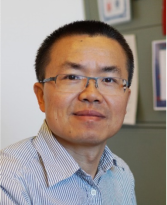

报 告 人: 殷亚东(Yadong Yin) 美国加州大学河滨分校
报告时间: 2022-11-30上午10:00~下午12:00
报告地点: 腾讯会议(ID:621-278-952)
组织单位: 曾华强教授团队
报告内容简介:
After nearly three decades of effort, it is now possible to synthesize nanostructured materials of well-controlled composition, size, surface functionalization, and physical properties. The next phase of nanotechnology development is the controlled assembly of nanoscale building blocks into desired superstructures up to bulk dimensions and precise positioning them at the desired locations, which, however, remain key challenges due to the lack of effective tools and mechanisms. In this presentation, we report our recent progress in this direction. We first describe the self-assembly of uniform superstructures at all scales using an emulsion-based template-assisted self-assembly strategy. This new strategy is designed by taking advantage of the partial miscibility of the solvent mixture, which makes it possible to generate transient emulsion droplets containing the target building blocks and carry them into templating holes patterned on a substrate, producing well-defined superstructures with the positional order defined by the template. This strategy is simple, low-cost, high-throughput, and scalable, and it demonstrates high controllability and general applicability in producing superstructures. Secondly, we report an Electric Field-Assisted Surface-Sorption nano-Printing (EFASP) method to allow fast, nanometer-precision printing of nanoparticles over large areas with high reproducibility. As an additive nanofabrication method, it utilizes a tip-based high-voltage writing process to generate nanoscale de-fluorinated patterns in a fluorinated surface, which not only enables electrostatic trapping but also creates a high local surface potential in contrast to the fluorinated area. As a result, the method combines dielectrophoretic enrichment and deep surface-energy modulation, featuring high efficiency and extraordinary robustness of nanoparticle printing. The method also supports the combinatorial pattern of multiple functional nanoparticles for realizing multi-color printing by conveniently repeating the writing and assembly cycles.
报告人简介:
Prof. Yadong Yin received his Ph.D. in 2002 from the University of Washington, Seattle, by working with Prof. Younan Xia. In 2003 he became a postdoctoral fellow at the University of California, Berkeley, under the supervision of Prof. A. Paul Alivisatos, and then a staff scientist at Lawrence Berkeley National Laboratory in 2005. He joined the Department of Chemistry, University of California, Riverside in 2006, and became a Full Professor in 2014. He is a recipient of the Cottrell Scholar Award (2009), DuPont Young Professor Grant (2010), 3M Nontenured Faculty Grant (2010), NSF CAREER award (2010), NML Researcher Award (2016), MRS Fellow (2020), and Langmuir Lectureship Award (2022). Being recognized as one of the world's most highly cited researchers by Clarivate Analytics from 2014 to 2021, he is currently an associate editor of the Journal of Materials Chemistry C and Materials Advances, and serves on the editorial board of many journals, including Advanced Functional Materials, Science China Materials, Research, Nano Letters, and Chemical Reviews.
 |